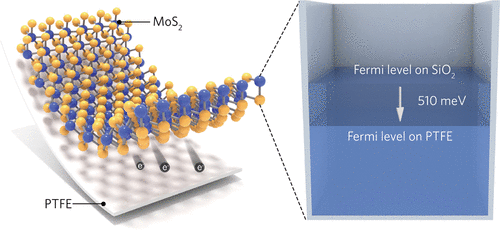当前位置:
X-MOL 学术
›
ACS Appl. Mater. Interfaces
›
论文详情
Our official English website, www.x-mol.net, welcomes your
feedback! (Note: you will need to create a separate account there.)
Reversing the Polarity of MoS2 with PTFE
ACS Applied Materials & Interfaces ( IF 8.3 ) Pub Date : 2021-09-16 , DOI: 10.1021/acsami.1c11328 Hanqi Liu 1 , Kun Ba 1 , Saifei Gou 2 , Yawei Kong 3 , Tong Ye 1 , Jiong Ma 3 , Wenzhong Bao 2 , Peng Zhou 2 , David Wei Zhang 2 , Zhengzong Sun 1, 2
ACS Applied Materials & Interfaces ( IF 8.3 ) Pub Date : 2021-09-16 , DOI: 10.1021/acsami.1c11328 Hanqi Liu 1 , Kun Ba 1 , Saifei Gou 2 , Yawei Kong 3 , Tong Ye 1 , Jiong Ma 3 , Wenzhong Bao 2 , Peng Zhou 2 , David Wei Zhang 2 , Zhengzong Sun 1, 2
Affiliation

|
Pristine monolayer molybdenum disulfide (MoS2) demonstrates predominant and persistent n-type semiconducting polarity due to the natural sulfur vacancy, which hinders its electronic and optoelectronic applications in the rich bipolarity area of semiconductors. Current doping strategies in single-layer MoS2 are either too mild to reverse the heavily n-doped polarity or too volatile to create a robust electronic device meeting the requirements of both a long lifetime and compatibility for mass production. Herein, we demonstrate that MoS2 can be transferred onto polytetrafluoroethylene (PTFE), one of the most electronegative substrates. After transfer, the MoS2 photoluminescence exhibits an obvious blueshift from 1.83 to 1.89 eV and a prolonged lifetime, from 0.13 to 3.19 ns. The Fermi level of MoS2 experiences a remarkable 510 meV decrease, transforming its electronic structure into that of a hole-rich p-type semiconductor. Our work reveals a strong p-doping effect and charge transfer between MoS2 and PTFE, shedding light on a new nonvolatile strategy to fabricate p-type MoS2 devices.
中文翻译:

用 PTFE 反转 MoS2 的极性
由于天然硫空位,原始的单层二硫化钼 (MoS 2 ) 显示出主要和持久的 n 型半导体极性,这阻碍了其在半导体丰富的双极性区域中的电子和光电应用。当前在单层 MoS 2中的掺杂策略要么太温和而无法逆转重 n 掺杂的极性,要么太不稳定而无法创建满足长寿命和批量生产兼容性要求的坚固电子器件。在此,我们证明了 MoS 2可以转移到聚四氟乙烯 (PTFE) 上,聚四氟乙烯 (PTFE) 是最具电负性的基材之一。转移后,MoS 2光致发光表现出从 1.83 到 1.89 eV 的明显蓝移和从 0.13 到 3.19 ns 的延长寿命。MoS 2的费米能级显着降低了 510 meV,将其电子结构转变为富含空穴的 p 型半导体。我们的工作揭示了 MoS 2和 PTFE之间强烈的 p 掺杂效应和电荷转移,揭示了制造 p 型 MoS 2器件的新非易失性策略。
更新日期:2021-09-29
中文翻译:

用 PTFE 反转 MoS2 的极性
由于天然硫空位,原始的单层二硫化钼 (MoS 2 ) 显示出主要和持久的 n 型半导体极性,这阻碍了其在半导体丰富的双极性区域中的电子和光电应用。当前在单层 MoS 2中的掺杂策略要么太温和而无法逆转重 n 掺杂的极性,要么太不稳定而无法创建满足长寿命和批量生产兼容性要求的坚固电子器件。在此,我们证明了 MoS 2可以转移到聚四氟乙烯 (PTFE) 上,聚四氟乙烯 (PTFE) 是最具电负性的基材之一。转移后,MoS 2光致发光表现出从 1.83 到 1.89 eV 的明显蓝移和从 0.13 到 3.19 ns 的延长寿命。MoS 2的费米能级显着降低了 510 meV,将其电子结构转变为富含空穴的 p 型半导体。我们的工作揭示了 MoS 2和 PTFE之间强烈的 p 掺杂效应和电荷转移,揭示了制造 p 型 MoS 2器件的新非易失性策略。











































 京公网安备 11010802027423号
京公网安备 11010802027423号